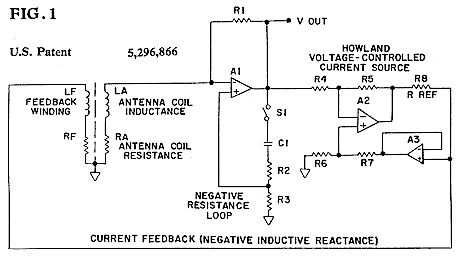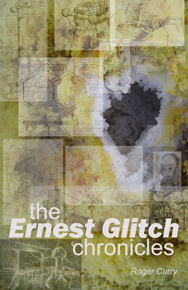Black Hole Antenna
JF Sutton and GC Spaniol 1993

"A Broadband Active Antenna for ELF Magnetic Fields" by John F. Sutton and G. Craig Spaniol" in Physics Essays March 1993, Vol 6, #1, 1993. Find a copy in large NASA PDF doc, Appendix D
Abstract: "A unique broadband ULF-ELF-magnetic antenna is described. Active circuitry is employed to introduce a negative impedance that combines with the wire resistance, the distributed winding capacitance, and the inductance of a physically small search coil to produce an antenna with a very small impedance. The result is increased search coil current and a enhanced dipole-plane wave field interaction, which greatly increases the effective area of the antenna, independent of frequency - a 'black hole' antenna."
The conclusion of the paper reads:
"We began our work with the known plane-wave electromagnetic field-resonant dipole electromagnetic field interaction which can explain equally well the enhanced effective areas of photon-atom, photo-particle, and radio wave-tuned dipole interactions. We have extended this principle by showing theoretically and demonstrating experimentally that active circuitry can be used to introduce negative impedances into an antenna circuit to reduce this same interaction over a broad band of frequencies. The interaction has been applied to enhance the sensitivity of physically small untuned search coils, used in the study of the ionosphere via the Earth-ionosphere cavity resonances, nominally in the 1 Hz - 100 Hz range. The active antenna frequency response has been measured and confirmed to be free for resonances and uniform, +/- 2dB, over a nearly four decade range of frequencies from 3.5 Hz to 25 kHz.
They site "C.F.Bohren and D.R.Huffman, "Absorption and Scattering of Light by Small Particles" (Wiley, 1983) saying it show Poynting vector field diagrams of the field interactions. Ref #22 of the paper.
Sir A. Fleming "On Atoms of Action, Electricity, and Light" in "The London, Edinburgh, and Bublin Phiosophical Magazine and Journal of Science" October 1932. Phil.Mag.S.7.Vo..14.No.92.Oct 1932
It shows "diagram representing the nature of the electromagnetic field near a receiving aerial in wireless telegraphy". Sucking like distortion field.
"Light absorption by a dipole" H. Paul and R. Fischer. Sov.Phys.Usp.26(10), Oct. 1983. American Institute of Physics.
Abstract: "In semiclassical radiation theory, the electric dipole moment induced on an atom by a strong incident field, absorbs much more energy, per sec, than is flowing through its geometrical cross section. This means, the atom has the capability to 'suck up' [that is what it says here, I'm not make it up] electromagnetic energy from a spatial region that is by far larger than its own volume. An intuitive understanding of the effect is provided by studying, in the framework of classical electrodynamics, the energy flow in the total field made up by superposition of the incident wave and the field that is generated by the dipole also in the absorptive case."
Some one wrote a note on the cover pages that reads "The German explanation is that it 'sucks'".
Related work by Sutton et.al. "Improved Analog Synchronous Demodulator: Output ripple is suppressed without an output filter" GSC-13179, NASA Tech Briefs, March 1992. Uses dual op-amp and 4053 CMOS switches.
"Digital Synchronous Demodulator: The digital version offers greater speed, precision, and reliability." GSC-13273.
"Broadband Active-Antenna: The effective area of a search coil is increased." GSC-13309. Single op-amp, search coil and a few passive components. This paper appears to be the patent application before the lawyers screwed it all up.
I don't have a copy of this one, but it seems to have great weight in GSC-13309 "How Can a Particle Absorb More Than the Light Incidence on It?" by Craig F. Bohren, Am. J. Phys. 51, No. 4, P.323, April 1983.
From GSC-13309: "With a tuned antenna there is always a tuned circuit including the antenna, where a capacitive reactancs is effectively cancelled by an inductive reactance which leads, in turn, to a large circulating current in the resonant circuit, which results in the production of a field. This field, in turn, interacts with the incoming field."
A lot of these are related to the Howland Voltage to Current converter to do regeneration.
Related by but not by Sutton et.al. is "Compact Electric and Magnetic-Field Sensor: A search coil and an electric-field dipole are collocated" NPO-19034. by D.Winterhalter and E.Smith. NASA Tech Brief Vol. 18, No. 10, Item #124 October 1994.
[Dr. Sutton came across this page, which resulted in these comments from him.]
Re: ACTIVE ANTENNA
From: John and Helen
Date: 10/02/05 10:54 pm
Hi Bob,
The synchronous detectors were used in temperature monitors and temperature controllers designed to control temperatures on spacecraft at 60 milliKelvin +/- a few ucroKelvin. The preamplifier had to have a gain of 10E5 after which the demodulated signal had to be converted by a 16 bit ADC, with +/- 1LSB allowable error.... so of course, you can see that we were working with extremely small signals buried in the noise, and we had to go all out in an effort to beat down the noise. That's why we had to use a new improved synchronous demodulator. This project was as close to being impossible as you can get! I still have trouble believing that we actually made it work.
The active ("Black Hole") antenna was developed in another project, where we didn't want to transport a two meter long antenna that weighed 200 pounds.....so we miniaturized the hardware while simultaneously expanding the antenna field cross section. We wanted to receive the entire ELF-VLF bands all at once, so we had to have an extremely broadband antenna....like four decades of bandwidth or more. You wouldn't believe the arguments I had with the reviewer at Physics Essays. He just couldn't believe that one could do what we did....and if it was indeed true, then why hadn't someone done it years ago?.., "and what makes you so smart", .so, of course, "this must be nonsense, etc....." Progress in physics is so bloody difficult because most physicists think that everything worthwhile has already been discovered....so they expect nothing new. This is negative feedback which, of course, makes the system stable, I suppose.
The one text book that includes diagrams of the antenna-external field interaction is listed as one of the references in the Physics Essays paper. Sorry, I can't remember the name of the autheor or the title.
John Sutton, Ph.D.
AH> I think Baurov's device is much more interesting than
this nonsense
AH> (sorry..) about an energysucking antenna.
BillB Wrote ---
Um... I think you'd better read the Bohren and the Paul/Fischer papers
listed in the references. This stuff is totally conventional (it is
classical EM applied to light absorbtion by small particles, the particles
not necessarily being atoms.) If the small particle has a resonance at
the frequency of the EM radiation incident upon it, then the
particle
absorbs far more energy than its size would allow.
Essentially, the
strong AC fields produced by the EM energy stored in the
particle act like
a dipole antenna. If the particle diameter is around 1/2
wavelength of
the EM radiation in question, then nothing odd will
occur. However, if
the particle diameter is far smaller than 1/2 wavelength, then the AC
fields give it large EA Effective Aperture, making it behave as if it
were a large dipole antenna (it electrically behaves far larger than its
physical diameter.)
> Baurov is supposed to have a theory which does make at
least some sense,
> and a working device....
>
> Also, I think Baurov's theory is related to Shipov's
torsion theory. I
> cannot say that about these energysucking fantasies.
(sorry...)
Strong words. Better make sure they are based on knowledge, not upon
emotion.
In antenna theory, refer to the EA "Effective Aperture" or "Effective
Area" phenomon. Those three physicists instead call it "energy-sucking."
In other words, do you think that EA of antennas is a fantasy? Really?
Portable AM radios efficiently receive signals even though they lack a
long-wire antenna. I had always thought that this was explained by the
fact that the input stage of the radio has fairly high gain, and that the
"loopstick" antenna coil was simply behaving as an inductive pickup coil.
Now I'm not so certain. Instead, that loopstick is *ALWAYS* connected to
a variable capacitor, and tuned to resonance. In that case the fields build
up enormously (for high-Q resonator,) which vastly increases the EA
"effective aperture" or "effective area" of the relatively tiny loopstick.
The antenna then collects RF energy over an immense disk-shaped region,
and NOT just over the length of the ferrite rod. The same applies to
"crystal radios". Is the coil and capacitor on the input of your crystal
radio actually acting as a filter? (Is it merely rejecting unwanted radio
stations?) Or instead is it acting as an active "resonance antenna," where
if the resonator is removed, the crystal radio stops working?
Since the ferrite coil in an AM radio or crystal radio is intentionally tuned
to resonate with the radio station being received, then the capacitor/coil
will generate an AC dipolar magnetic field. When superposed on the
incoming EM plane waves, this dipolar magnetic field distorts the plane
waves, and they bend inwards and deliver far more energy to the coil than
we'd expect. And, if we plot the shape of the Poynting vector field
surrounding the antenna, we find a strange kind of "funnel" effect where
the antenna gathers a fairly large area of energy flux by bending the
energy flux inwards so it is absorbed by the antenna.
Or think of it like this: a very sparse diluted gas of sodium atoms in a
hot glass ampoule, if it's viewed under sodium yellow light from a
discharge tube ...looks completely black! Yet for off-resonance light
(even if the frequency is nearby,) the same ampoule looks transparent.
The 2-angstrom sodium atoms have seemingly increased in size, as if they
were enormous particles of carbon-black. That's the EA antenna aperture
effect of an electrically-short resonator. Single atoms do it. But so do
LC tank circuits. So does your hand-held AM radio. The "size" of the
absorbing antenna can only grow to roughly 1/4 or 1/3 wavelength.
For sodium atoms in a gas, each 0.2nM atom grows to 590nM/4 diameter, so
its sectional area increases by a factor of 421,000 or roughly half a
million
(but only when the frequencies match at resonant peak. Remove the
resonance, and the 421k times increased absorption disappears.)
We see this same effect in Yagi/Uda antennas, where the "director" elements
cause the incoming waves to bend towards the main dipole.
Here's yet another way to see it. In order to receive, an antenna MUST
transmit. Otherwise it won't interact with the incoming EM waves. But
the wave-absorption process is really an example of 180deg phase-cancellation.
The receiving antenna emits a sphere-wave, but one which creates an
interference pattern when it sums with the incoming wave. And downstream
from the antenna, a big dark EM-shadow appears: a node in the pattern. By
transmitting an anti-wave, the receiving antenna "appears larger." It
acts
as if it's a black disk roughly 1/4 wavelength across. When we use half-
wave dipole antennas, the antenna sucks in waves which pass to the sides of
the wires ...but the received energy is roughly what you might predict.
However, if the receiving antenna is hundreds or thousands of times smaller
than one wavelength, we can force it to absorbe immense energy if we
connect
it to a resonant tank-circuit. It's the same "black sodium-gas" effect!
